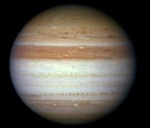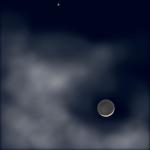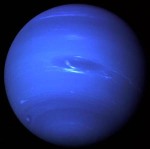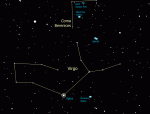The Planets Dance Across September's Night Sky
September is one of the year's most entertaining and awe-inspiring months to lay on your back on a dark hill and view the delights of the celestial dance in the sky above you as your ancestors once did on a nightly basis. Four of Sol's dance partners will be in the spotlight in September, 2010, taking part in a nightly dance that includes their less observable brothers and sisters, while Mercury will once again dance privately in the eastern sky each morning during September.
Mighty Jupiter will rule the night's sky in the Northern Hemisphere during September, especially after he reaches the point in his orbit opposite the sun as seen from SpaceshipEarth1, which space scientists call Jupiter's opposition. This celestial event will occur on the last day of summer in the Northern Hemisphere, on this day the 24 hour period of the day will be evenly separated into night and day, and the evening temperature will still be warm enough to make star-gazing comfortable. The perfect time to set up your celestial time machine to the stars or to just lay back on the cold Earth and watch the celestial dance above you unfold before your eyes as millions of your ancestors have since mankind first perceived the possibilities the night's sky creates in the human imagination. This will be the most comfortable and best time to view Jupiter in the past 47 years and it will definitely be more comfortable viewing than during Jupiter's next opposition on October 29, 2011. During Jupiter's opposition on October 29, 2011, the weather will be a lot of colder than on September 21, 2010, and you'll have to wait another year to have a look at the largest planet in our solar system.
Mighty Jupiter will be at his brightest when he reaches opposition on September 21, 2010 and on this night the King of Sol's planets will shine brighter in the night's sky than during anytime in the past 47 years. Jupiter will also appear bigger during its September 21, 2010 opposition, subtending an angle of almost 50 ", and shining at magnitude 2.9. This means that after Venus sets at around 8 P.M., mighty Jupiter will be the brightest star like object in September's night sky.
Mighty Jupiter will travel near the border between the constellations of Aquarius and Pisces for several months on both sides of opposition. This region of space-time has few bright stars to outshine Jupiter and the contrast allows viewers to get a good look at Jupiter. The nearest 1st magnitude star, Fomalhaut (Alpha) Piscis Austrini, is over 30 degrees away and mighty Jupiter is easily observed in the night's sky at this time.
Star gazers in the mid-northern latitudes will find that due to their location mighty Jupiter only climbs halfway up the night's sky in September, 2010. This doesn't make for the best viewing during Jupiter's opposition and Jupiter's altitude will be at its greatest at local midnight time. Star gazers at latitude 40 degrees north will therefore see Jupiter at 48 degrees above the southern horizon. In the northern hemisphere of Earth, star gazers will view Jupiter 1 degree higher in the night's sky, for each degree of latitude south of 40 degrees north at which they're viewing Jupiter. In contrast, for each 1 degree north of 40 degrees north at which you observe Jupiter, you'll see Jupiter 1 degree lower in the night's sky.
Star gazers that want to view mighty Jupiter as he dances across September's night sky can so so without a pair of binoculars. Star gazers will need a pair of binoculars or telescope to see Uranus, Sol's seventh planet will lie within 2 degrees of Jupiter throughout September, and can be difficult to view Uranus at this time. Sol's eighth planet, Neptune, will be found about 30 degrees west of Jupiter and Uranus during September. Star gazers that want to view Venus and Mars should look in the evening twilight near Virgo's brightest star, Spica.
We'll begin our journey across September's night sky during the first week of Earth's ninth month, at this time Saturn will be dancing in the twilight of the low horizon of September's night sky. We'll board our time machine to the stars and planets on September 1 and start the first leg of our celestial journey to the beginning of the universe in human terms by traveling across space and time to Saturn. Sol's ringed planet will set an hour after the sun on this day and can be found dancing in the sky about 5 degrees above the horizon, after the sun goes down.
To locate Saturn, use Venus as your visual guide. Earth's evening star will be visible a few minutes after the sunsets. Look for Spica in the constellation Virgo, to the right of Venus. Saturn and Spica glow at the same relative magnitude, so if you take your time and can find Spica, you should be able to see Saturn in the night's sky above you. Saturn will be found 20 degrees to the right of Venus in September's night sky and at around half the distance from the horizon as Venus. Saturn will continue to be viewable from Earth, throughout the first week of September, 2010, and viewing Saturn from SpaceshipEarth1 will become increasingly difficult after this time.
On September 1, 2010, Venus will be dancing in the night's sky in line with Spice and Mars. Spica will be in the middle of this dance, and if you continue to watch this celestial dance unfold for two more nights, Spica will dance toward the center of the trio. The trio will begin to fallback from each other as September enters the second week and will form an ever-widening triangle. Venus will shine the brightest during this celestial dance across September's night sky, while Spica will outshine Mars as the trio does their nightly dance across the skies of September.
On September 10 a crescent moon will join this celestial dance. Mars will be viewable about 6 degrees above the Moon, while Venus will be to the lower left of Mars. Continue to watch this dance unfold and you'll see the Moon travel 6 degrees to the left of Venus by the time September 11, 2010 arrives. The Moon will also grow in visible size each night after September 11, 2010, until reaching full moon at 5:17 A.M. EDT on September 23.
Venus will continue to be viewable in September's night sky as she dips closer to the horizon each night during September. Venus will shine her brightest on September 23, 2110, when the evening star will shine at magnitude 4,8 and will set an hour after Sol retires for the night. Watch Venus during this time and she'll draw you into her nightly dance and fascinate you as she goes through obvious changes in visible size and phase. View Venus on September 1 and you'll see a planet with a disc 29 " across and at 41 percent illumination. By the time the dance reaches September 30, Venus has slimmed to 19 percent illumination and swelled to about 45 ", a change that can be easily discerned by patient star gazers.
Mars will appear small and dim compared to the Evening Star, the Red Planet will shine at magnitude 1.5 throughout September 2010, which is around 300 times dimmer than Venus will shine. Mar's disk also measures only 4" and very little detail will be seen by viewers looking at Mars through a telescope. Mars will become more visible late in 2011, so if you want to have the best view of Mars, you'll have to wait until this time.
September will be a great time to view Sol's ninth planet though as Pluto will dance an elegant loop in northwestern Sagittarius, close to an 8th magnitude star that's only 2.6 degrees north-northwest of 4th magnitude Mu Sagittarii. This will make this 14th magnitude dwarf planet, which many claim isn't really a planet, easier to view due to its proximity to this relatively bright star. You'll still require an 8-inch telescope and a dark sky to be able to see Pluto in September's night sky, but the view is spectacular, and you can get a good idea of the distance involved.



